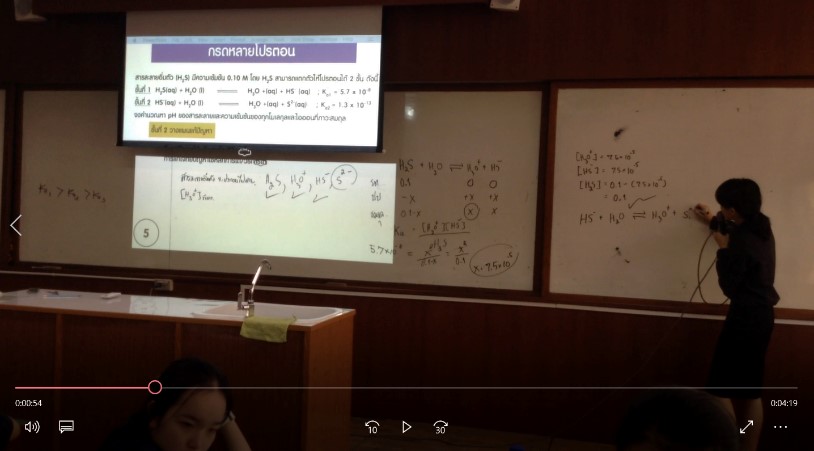การพัฒนาทักษะกระบวนการแก้โจทย์ปัญหาเคมี เรื่อง กรด-เบส โดยใช้กระบวนการแก้ปัญหาของโพลยาสำหรับนักเรียนชั้นมัธยมศึกษาปีที่ 5
Main Article Content
Abstract
Waratthaya Maneerattana and Piyarat Dornbundit
รับบทความ: 6 สิงหาคม 2560; ยอมรับตีพิมพ์: 20 พฤศจิกายน 2560
บทคัดย่อ
งานวิจัยนี้วัตถุประสงค์พัฒนาทักษะกระบวนการแก้โจทย์ปัญหาวิชาเคมี เรื่อง กรด–เบส ของนักเรียนระดับชั้นมัธยมศึกษาปีที่ 5 โดยใช้กระบวนการแก้ปัญหาของโพลยา เครื่องมือที่ใช้ในการวิจัยครั้งนี้ ได้แก่ แผนการจัดการเรียนรู้วิชาเคมี เรื่อง กรด–เบส ที่จัดการเรียนรู้ด้วยห้องเรียนกลับทาง แบบวัดทักษะกระบวนการแก้โจทย์ปัญหาเคมี เรื่อง กรด–เบส และสื่อออนไลน์ ClassStart.org กลุ่มที่ศึกษาเป็นนักเรียนระดับชั้นมัธยมศึกษาปีที่ 5 ที่เรียนในภาคเรียนที่ 2 ปีการศึกษา 2559 จำนวน 24 คนของโรงเรียนแห่งหนึ่งในกรุงเทพมหานคร ผลการศึกษา พบว่า ทักษะกระบวนการแก้โจทย์ปัญหาของนักเรียนกลุ่มที่ศึกษามีคะแนนหลังเรียนสูงกว่าก่อนเรียน (p < 0.05)
คำสำคัญ: ทักษะกระบวนการแก้โจทย์ปัญหา กระบวนการแก้ปัญหาของโพลยา กรด–เบส
Abstract
The research aimed to develop problem–solving skills in chemistry on the topic of acid–base of grade–11 students by using Polya’s problem–solving process. The research instruments were learning plans of chemistry on acid–base using flipped classroom, an evaluating form of problem–solving skills on acid–base and online multimedia ClassStart.org. The study group was twenty–four grade–11 students in 2nd semester of academic year 2016 from a school in Bangkok. The finding revealed that students’ problem–solving skills after learning on acid-base using the Polya’s problem–solving process was significantly higher than that before learning (p < 0.05).
Keywords: Problem-solving skills, Polya’s problem-solving process, Acid-base
Downloads
Article Details

This work is licensed under a Creative Commons Attribution-NonCommercial 4.0 International License.
References
Gilbert, J. K. (2006). On the nature of context in chemical education. International Journal of Science Education 28: 957–976.
Gabel, D. (1999). Improving teaching and learning through chemistry education research: A look to the future. Journal of Chemical Education 76(4): 548–554.
Osborne, J. F., and Collins, S. (2000). Pupils’ and Parents’ View of the School Science Curriculum. London: King’s College London.
Artdej, R. (2010). Thai Grade 11 students’ alternative conceptions for acid–base chemistry. Research in Science & Technological Education 28(2): 167–183.
Bunsu, S. (2003). Effect of Problem Solving’s Training Package Emphasize Mind Map-ping Technique on the Chemistry Achievement of Mattayomsuksa Four Students. Unpublished Master’s Thesis. Bangkok: King Mongkutt’s Institute of Technology Ladkrabang. (in Thai)
Adegoke, S. O. (1990). The Effect of Polya and Six-Stage Heuristic Problem Solving Instruments on Students Achievements in Secondary Schools. Unpublished PhD Thesis. Nigeria: University of Ilorin, Nigeria.
Lee, S. (2015). Students’ use of “Look Back” strategies in multiple solution methods. International Journal of Sciences and Math Education 14(4): 701–717.
Yuan, S. (2013). Incorporating Polya’s problem solving method in remedial math. Journal of Humanistic Mathematics 3(1): 96–107.
Han, K., and Kim, Y. (2016). The effect of Polya’s heurictics in mathematical problem solving of mild disability students. East Asian Mathematical Journal 32(2): 253–289.
Polya, G. (1975). How to solve it? A new Aspect of Mathematical Method. USA: Princeton University.
Bilgin, I. (2006). The effects of pair problem solving technique incorporating Polya’s problem solving strategy on undergradduate students’ performance in chemistry. Journal of Science Education 7: 101–106.
Wachararangsee, P. (2005). The Development of Problem Solving Ability of Sixth Grade Students Taught by STAD Technique together with Polya’s Problem Solving Process. Unpublished Master’s Thesis. Bangkok: Silapakorn University. (in Thai)
